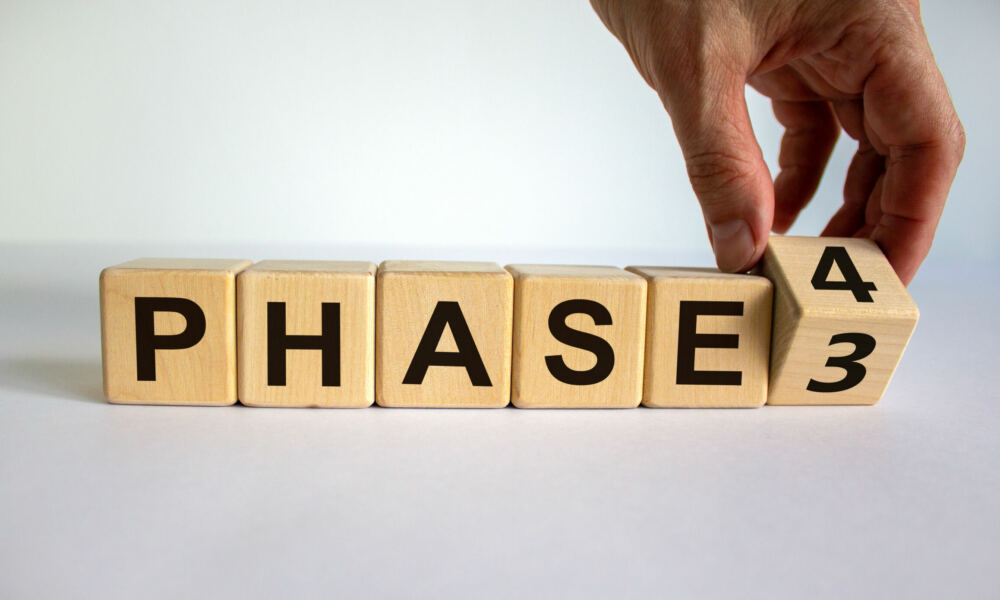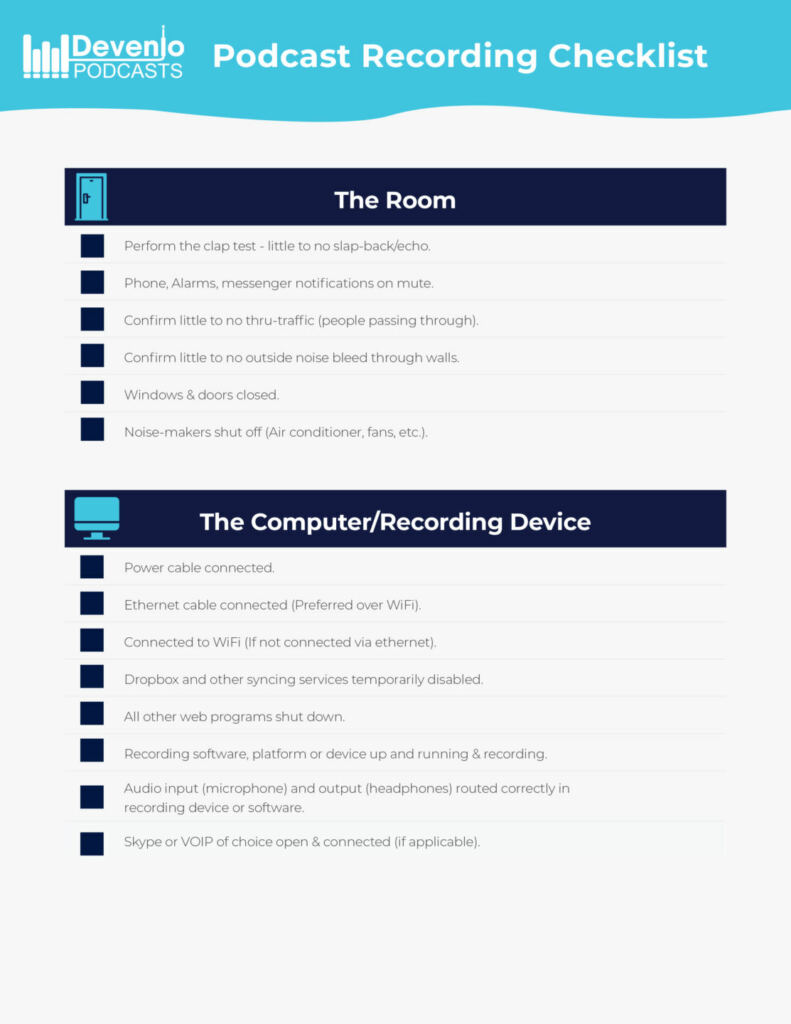Are you new to podcasting and feeling overwhelmed about where to start and what to do? You’re not alone!
Publishing a podcast episode can seem daunting, but it doesn’t have to be. You will find that it doesn’t take long to get into the podcasting groove and streamline your show for success right from the start.
Here is a step-by-step guide to help you through the process. We’ll cover all you need to know to publish a podcast episode seamlessly from pre-production to post-production and everything in between. Let’s get started!
Phase 1: Pre-Production & Planning

First, we’ll plan and prepare everything we need to record the episode. This is known as the Pre-Production phase (or PrePro). We can break this into a few different steps.
IDEATION

It all starts with the idea or topic of your episode. In the pre-production phase, you’ll brainstorm the concept of your episode and find something that will resonate with your audience. It’s during this process that you should ask yourself:
- Who are my listeners?
- What are their pain points?
- How can I bring them value?
Once you’ve nailed down a general concept for your episode, we recommend brainstorming a few catchy titles for a podcast episode; think of this as your elevator pitch. This exercise will break down your episode concept into its simplest form and will help you focus on the key topics you want to address. It will also make the other steps of the production process a little easier as you will refer back to this simple idea while drafting your episode outline all the way through marketing your podcast episode.
FORMATTING

Now that you’ve landed on a topic, it’s time to decide on a format for your episode. You can structure the format of your podcast in a number of different ways. The most common format is the Q&A, or interview format. This is where you have a guest on your show for an interview where they can provide some unique insights around the topic being discussed based on their experience and expertise.
But formatting doesn’t have to stop there. You can do a countdown of the top five trade tools to use in your industry, repurpose content from other channels (like video), or use recorded content from live events as an episode. In fact, we just published a blog on how you can turn your live event into an ongoing podcast series, you can check it out here!
You can even take multiple format ideas and combine them into one cohesive episode. For example, using recorded audio from a live event and finding a guest who can add some additional commentary in an interview on a single topic. The sky’s the limit when it comes to episode formatting and feel free to get as creative as you’d like – just remember to tie it all back to your basic concept.
CHOOSING YOUR GUEST

If you’ve decided to have a guest on the show, ask yourself: which industry expert or thought leader would be a good fit for your podcast episode’s topic?
Here are a few things to consider when choosing a guest for your episode:
- Will they bring a unique perspective to the topic being discussed and will your audience want to hear from them?
- Are they available to record in a realistic timeframe or is their schedule slammed?
- Do they have an existing audience that they’d be willing to share the episode with, exposing your podcast to a wider audience?
- If they have a podcast, is there an opportunity to trade guests? Maybe you could appear as a guest on their show as well.
STRUCTURING

No matter which format you’ve chosen for your episode, you’re going to want to draft some sort of outline or script. At its heart, just like any other content, podcasting is a form of storytelling and building your episode from an outline will help you structure your episode and keep you on track during the recording. We published a blog on episode planning and outlining, so if you want to dive deeper into drafting your outlines, you should definitely check it out!
SCHEDULING

After you outline your episode, you can move on with scheduling the episode recording. If you’re recording the episode in-person, choose a location that’s suitable for the number of speakers and ensure you have all the necessary equipment. If recording the episode virtually, it’s time to find a recording platform for virtual recording via VoIP or other forms of online communication.
Last but not least, ensure your guest has a copy of the questions and/or the outline. The goal is to help the guest prepare for the recording and feel as comfortable as possible when it comes time to hit the record button.
Phase 2: Recording & Production

We’ve finally arrived at the production part of the workflow. This is where you hit record and let the conversation flow, but before you do, we have a few tips to help you maximize your recording time. These tips can help organize your process so you don’t have to worry about re-recording or complicating the post-production phase (which we’ll talk about later).
First, we recommend using a podcast recording checklist throughout the session to have a step-by-step list of tasks to preform prior to hitting the record button. This will decrease the risk of forgetting anything that can completely hamstring the recording and ultimately waste time for you and your guests. For example, you wouldn’t want to start recording a virtual episode and realize your guest is on a spotty WiFi connection halfway through!
Ultimately, our mantra is to “get the recording right at the source.” In other words, you should try to get the best sounding recording possible before any processing. Even with all the post-production tools we have to help clean up and maximize our recordings, your final product will sound only as good as the source recording. If there’s a lawn mower in the background throughout your recording, all the post-production in the world won’t be able to completely remove it. Instead, removing it at the source by closing the window will pay off down the line.
Phase 3: Post-Production

Now that you recorded your audio, it is time to clean and chisel all that content into a fantastic podcast episode! We always recommend using an audio professional for this phase but if you want to tackle it yourself here are a few things to consider.
EDITING
During the editing process, you want to remove any “Ums”, “Ahs”, stutters, or background distractions that may have been caught on a live mic. Anything that takes your audience’s focus away from the subject matter should be cut or pushed to the background. You’ll also want to consider the length of your episode and make content cuts to fit your episode within the desired time frame. We recommend podcast lengths somewhere between 30-60 minutes but this ultimately depends on the episode subject matter and format.
MIX & MASTER
Once you’ve cut down your episode in editing and cleaned things up, it is time to mix and master the audio. You can utilize tools like noise suppressors to diminish background noise, EQ (Equalizers) to remove annoying frequencies and compressors to smooth out the dynamics and level out the volumes between speakers. All of these tools will help enhance the quality of your audio and make your episode sound more polished and professional.
Phase 4: Publishing & Marketing

It’s done. Your podcast episode is recorded and mixed. It’s time to hit the publish button and share it with the world! By now, you should have a hosting provider and an RSS feed created. In the publishing phase, you’ll upload your audio file to the hosting provider and schedule the date and time you’d like to publish and distribute to all your subscribers. You’ll also need to finalize your episode title and draft your show notes, which serve as a brief summary to your episode. If you have a guest on your show, be sure to include their background and contact information for your listeners.
Once the episode is published live by your hosting provider, we recommend embedding the episode on your blog or company website along with the show notes. Some hosting platforms offer built-in podcasting websites that you can utilize as well!
From here, you can begin focusing on marketing your content to your subscriber base and target audiences. When crafting your messaging, think all the way back to the basic concept of your episode (that elevator pitch) and use that as much as you can.
You can start with an email to your circulation list with links to the episode and schedule social posts to engage your target audience in areas where your subject matter is valuable.
If you have a guest on your show, be sure to provide them with marketing material to help cross-promote your new episode with a broader audience. Guests are usually happy to spread the word on projects they are involved with.
Conclusion
We know there’s a lot to unpack here, but once you master each of these four phases, you’ll find that you’ll fall into a nice podcasting groove, streamlining your processes and operating like a well-oiled machine.
What are you waiting for? Now that you have the template, it all starts with episode one!




